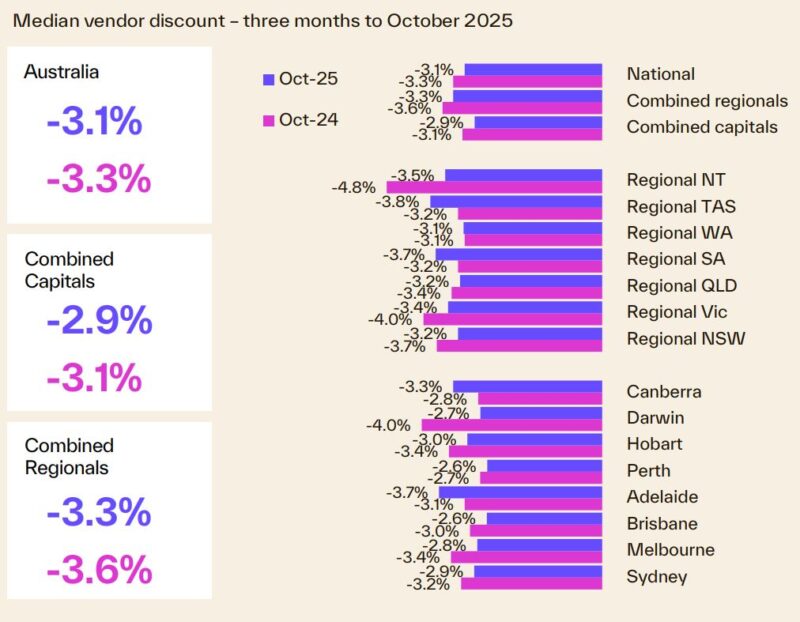
Key takeaways
While interest rates and inflation dominated headlines early in the year, property values quietly marched higher in most markets, proving once again that sentiment and fundamentals often tell two very different stories.
What stands out most this year is how consistent the recovery has been.
It now seems that interest rates are unlikely to fall again anytime soon. However, there are still strong fundamentals driving our housing markets.
This week, Cotality also reports that:
Sydney property prices increased 0.1% over the last week, increased 0.3% over the last month and are 5.1% higher than they were 12 months ago.
Melbourne property prices increased 0.1% over the last week, increased 0.2% over the last month, and increased 4.4% compared to 12 months ago.
Brisbane property prices increased 0.3% over the last week, increased 1.7% over the last month and are 13% higher than they were 12 months ago.
Overall, Australian capital dwelling prices increased 0.8% over the last month and are now 7.3% higher than they were 12 months ago.
Clearly, the property cycle is moving
The capital city preliminary auction clearance rate continued its easing trend that has been evident since mid-September, falling 4.7 percentage points to 63.5% last week, the lowest since the same time last year (62.4%).
The volume of capital city auctions also trended lower, down 5.5% from the previous week, with 3,238 homes going under the hammer last week.
This current property cycle has been driven by an undersupply of good properties relative to current demand pushing up property values and rents there was nothing to suggest there will be any significant change in the near future.
Unfortunately, the undersupply properties is going to persist for some time with all commentators agreeing that there is no way we're going to hit the housing construction targets required to meet our demand.
It’s fair to say that 2025 has been a year where Australia’s property markets reminded everyone why housing here is a long game.
No fireworks, no doom-laden crashes, no runaway booms - instead, we’ve seen a steady, broad-based resilience that reflects the country’s chronic undersupply, strong demographic drivers and the simple reality that people prioritise having a roof over their heads, no matter what the economic cycle throws at them.
While interest rates and inflation dominated headlines early in the year, property values quietly marched higher in most markets, proving once again that sentiment and fundamentals often tell two very different stories.
What stands out most this year is how consistent the recovery has been.
Even though affordability pressures persisted, well-located, family-friendly homes and investment-grade properties continued to outperform. The flight to quality accelerated, widening the gap between A-grade properties and everything else.
Another defining feature of 2025 has been the sharp divergence between markets. Some capitals surged ahead, supported by strong migration and very limited construction pipelines, while others delivered more modest growth.
But in every city, one theme kept reappearing: supply simply hasn’t kept up.
With building approvals still far below what’s needed and construction costs keeping expansion subdued, the “housing shortage” narrative has shifted from a temporary imbalance to a structural national challenge.
This scarcity underpinned price growth, bolstered investor confidence and continued to push rents higher.
On the auction front this week... preliminary auction clearance rate continues to ease
The capital city preliminary auction clearance rate continued its easing trend that has been evident since mid-September, falling 4.7 percentage points to 63.5% last week, the lowest since the same time last year (62.4%).
The volume of capital city auctions also trended lower, down 5.5% from the previous week, with 3,238 homes going under the hammer last week.
See Cotality's full auction report below.
This week, Cotality also reports that:
- Sydney property prices increased 0.1% over the last week, increased 0.3% over the last month and are 5.1% higher than they were 12 months ago.
- Melbourne property prices increased 0.1% over the last week, increased 0.2% over the last month, and increased 4.4% compared to 12 months ago.
- Brisbane property prices increased 0.3% over the last week, increased 1.7% over the last month and are 13% higher than they were 12 months ago.
Overall, Australian capital dwelling prices increased 0.8% over the last month and are now 7.3% higher than they were 12 months ago.
Clearly, the property cycle is moving on but our markets are very fragmented.
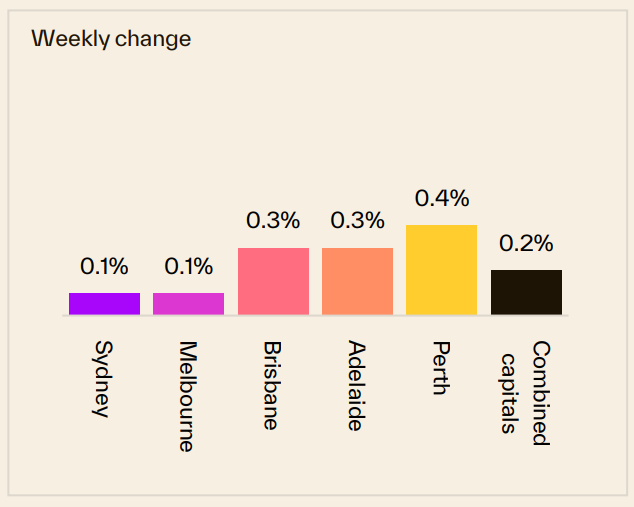
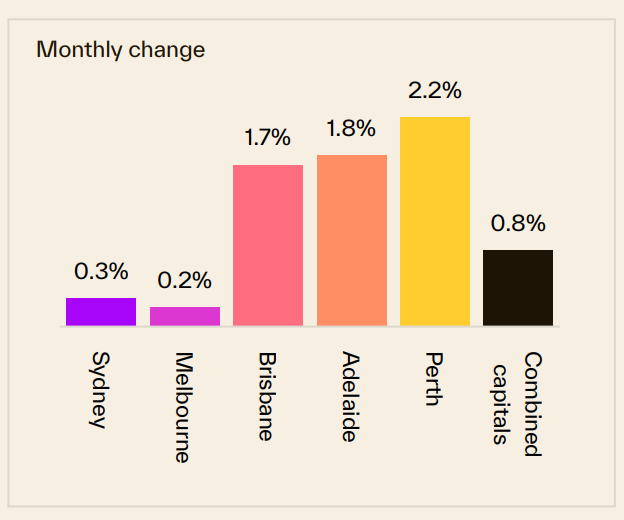
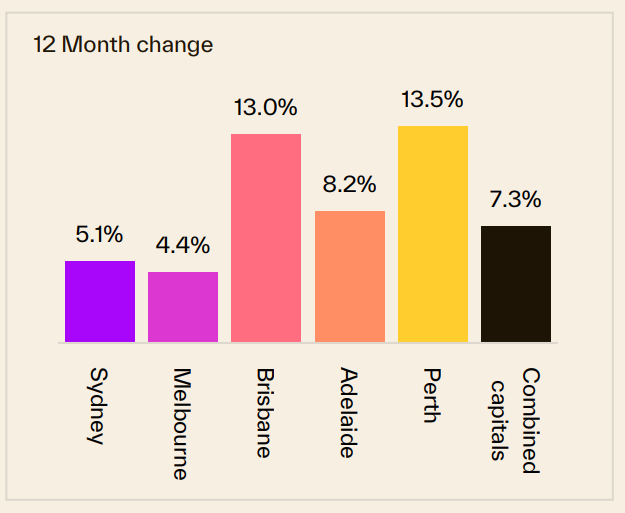
Source: Cotality December 8th 2025
Of course, these are "overall" figures - there is not one Sydney or Melbourne or Brisbane property market.
And various segments of each market are performing differently.
At the beginning of this cycle the upper quartile of the market lead the upswing but last year the lower quartile across every capital city recorded a stronger outcome for housing values relative to its upper quartile counterpart.
The following chart shows how various segments of each capital city market are performing differently with median-priced properties performing well.
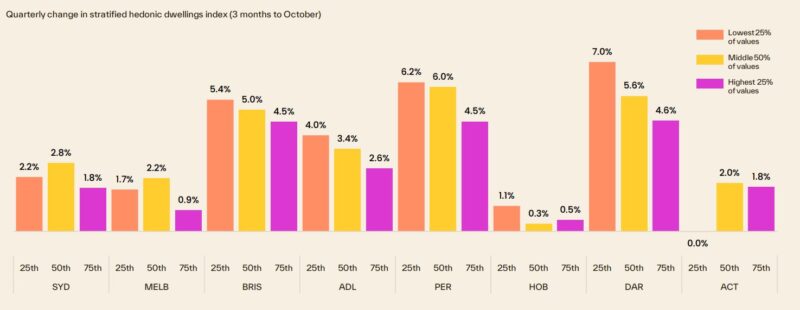
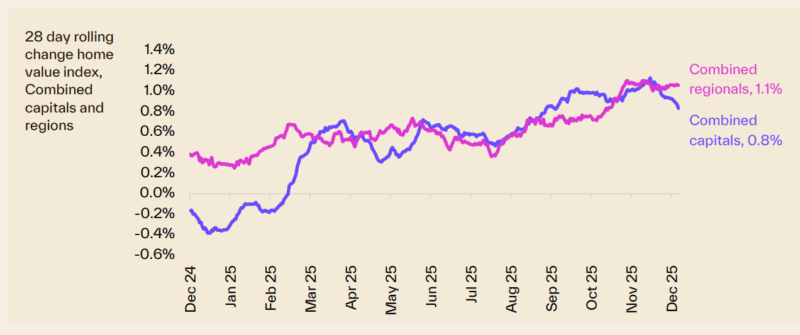
To help keep you up-to-date with all that's happening in property, here is my updated weekly analysis of data and charts as of 8th December 2025 provided by SQM Research, Cotality, and realestate.com.au.
Current property asking prices
Property asking prices are a useful leading indicator for housing markets - giving a good indication of what's ahead.
Here is the latest data available:
Sydney
| Property type | Price ($) | Weekly Change | Monthly Change % | Annual % change |
|---|---|---|---|---|
| All Houses | 2,133,491 | 2.209 | 1.5% | 9.7% |
| All Units | 879,273 | -1.773 | 0.3% | 6.0% |
| Combined | 1,621,672 | 0.584 | 1.2% | 8.6% |
Source: SQM Research
Melbourne
| Property type | Price ($) | Weekly Change | Monthly Change % | Annual % change |
|---|---|---|---|---|
| All Houses | 1,313,433 | 0.199 | 0.5% | 5.6% |
| All Units | 660,272 | 0.120 | 0.4% | 7.7% |
| Combined | 1,106,724 | 0.174 | 0.5% | 5.8% |
Source: SQM Research
Brisbane
| Property type | Price ($) | Weekly Change | Monthly Change % | Annual % change |
|---|---|---|---|---|
| All Houses | 1,370,269 | -0.376 | 2.7% | 15.1% |
| All Units | 834,221 | 8.779 | 4.0% | 23.7% |
| Combined | 1,235,174 | 1.931 | 2.9% | 16.3% |
Source: SQM Research
Perth
| Property type | Price ($) | Weekly Change | Monthly Change % | Annual % change |
|---|---|---|---|---|
| All Houses | 1,184,626 | -5.441 | -0.2% | 8.0% |
| All Units | 702,104 | 0.329 | 1.4% | 18.5% |
| Combined | 1,058,039 | -3.927 | 0.0% | 9.6% |
Source: SQM Research
Adelaide
| Property type | Price ($) | Weekly Change | Monthly Change % | Annual % change |
|---|---|---|---|---|
| All Houses | 1,099,488 | 0.212 | 3.0% | 14.5% |
| All Units | 592,632 | 2.968 | 0.9% | 22.1% |
| Combined | 1,008,235 | 0.708 | 2.8% | 15.3% |
Source: SQM Research
Canberra
| Property type | Price ($) | Weekly Change | Monthly Change % | Annual % change |
|---|---|---|---|---|
| All Houses | 1,288,454 | 9.908 | 0.8% | 6.6% |
| All Units | 588,924 | 2.938 | 0.8% | -1.7% |
| Combined | 1,025,320 | 7.286 | 0.8% | 4.1% |
Source: SQM Research
Darwin
| Property type | Price ($) | Weekly Change | Monthly Change % | Annual % change |
|---|---|---|---|---|
| All Houses | 789,978 | -0.978 | 0.7% | 12.8% |
| All Units | 454,173 | 5.452 | 2.2% | 18.3% |
| Combined | 657,932 | 1.550 | 1.1% | 14.2% |
Source: SQM Research
Hobart
| Property type | Price ($) | Weekly Change | Monthly Change % | Annual % change |
|---|---|---|---|---|
| All Houses | 861,950 | -1.769 | -1.0% | 6.8% |
| All Units | 515,192 | 3.508 | 3.5% | 5.4% |
| Combined | 808,994 | -0.963 | -0.6% | 6.6% |
Source: SQM Research
National
| Property type | Price ($) | Weekly Change | Monthly Change % | Annual % change |
|---|---|---|---|---|
| All Houses | 1,059,323 | -0.880 | 1.0% | 11.3% |
| All Units | 627,186 | 4.027 | 0.9% | 10.7% |
| Combined | 965,559 | 0.185 | 1.0% | 11.1% |
Source: SQM Research
Cap City Average
| Property type | Price ($) | Weekly Change | Monthly Change % | Annual % change |
|---|---|---|---|---|
| All Houses | 1,539,343 | -3.708 | 1.1% | 9.3% |
| All Units | 771,884 | -0.382 | 0.3% | 9.2% |
| Combined | 1,310,006 | -2.714 | 0.9% | 9.1% |
Source: SQM Research
The value of property asking prices as a leading indicator for housing markets is quite significant.
In fact it's more valuable than median prices which can be quite misleading.
Let's delve into why this is the case and how it impacts the real estate market.
- Early Market Sentiment Indicator: Asking prices often reflect the current sentiment of sellers in the real estate market.
If sellers are confident, they might set higher asking prices, anticipating strong demand.
Conversely, if sellers are uncertain or perceive a market downturn, they might lower their asking prices to attract buyers.
This makes asking prices a real-time indicator of market sentiment, often preceding changes in actual sales prices. - Predictive of Future Price Trends: Trends in asking prices can be predictive of where the actual property prices are headed.
For example, a consistent rise in asking prices over a period can signal an upcoming rise in transaction prices. - Impact of Economic Factors: Economic factors such as interest rates, employment rates, and broader economic health influence asking prices.
For instance, changes in the Reserve Bank of Australia's policies or shifts in the job market can quickly reflect in the asking prices, providing insights into how these factors are influencing the housing market. - Regional Variations: In a diverse market like Australia's, asking prices can also provide insights into regional disparities.
For instance, the property markets in Melbourne and Sydney might behave differently from those in Brisbane or Perth. Asking prices can give early indications of these regional trends. - Influence of Supply and Demand: Asking prices are also a response to the balance of supply and demand in the market.
In areas with limited supply and high demand, asking prices tend to be higher and vice versa.
However, it's important to note that while asking prices are a valuable indicator, they should not be used in isolation.
Other factors like actual sales prices, time on the market, auction clearance rates, and economic conditions also play crucial roles in understanding the property market dynamics.
READ MORE: The latest median property prices in Australia’s major cities
Last weekend's auction report
Preliminary auction clearance rate continues to ease
The capital city preliminary auction clearance rate continued its easing trend that has been evident since mid-September, falling 4.7 percentage points to 63.5% last week, the lowest since the same time last year (62.4%).
The volume of capital city auctions also trended lower, down 5.5% from the previous week, with 3,238 homes going under the hammer last week.
The number of auctions will cool further as we approach the festive season, with around 2,880 homes scheduled for auction this week, before dropping sharply to around 1,200 auctions over the week ending December 21.
Auction activity is likely to remain low until early February.
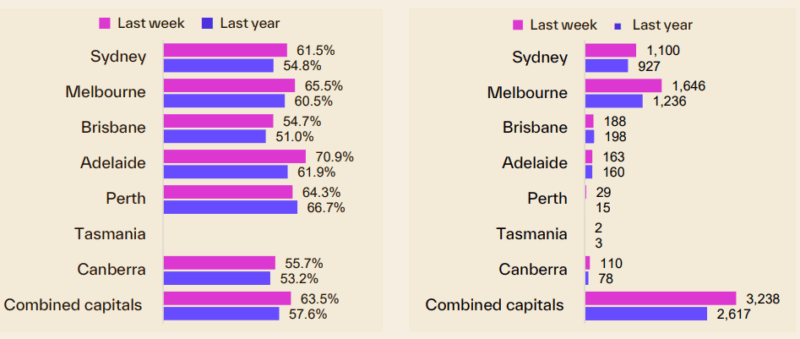
1,646 homes were auctioned across Melbourne last week, in-line with the week prior (1,643).
The preliminary clearance rate came in at 65.5%, down 3.1 percentage points to be the lowest early clearance rate since the last week of September (which coincided with the Melbourne Cup Racing Carnival).
Sydney hosted 1,100 auctions last week, 11.9% fewer than the week prior.
The preliminary clearance rate eased by 3.7 percentage points, coming in at 61.5%, the lowest since the week ending June 8th earlier this year (59.9%).
188 homes were auctioned in Brisbane last week, down 10% on the week prior.
The preliminary clearance rate fell sharply, down 16.8 percentage points to 54.7%, the lowest since the first week of May earlier this year.
There were 163 auctions held in Adelaide last week, down 12.8% relative to the week prior.
The preliminary clearance rate fell 14.3 percentage points to 70.9%.
Of the 110 auctions held in ACT last week, 55.7% have reported a successful result so far, down 9.7 percentage points from the previous week, marking the lowest early clearance rate since the week ending June 22 earlier this year.
29 homes were auctioned in Perth last week with a preliminary clearance rate of 64.3%, while only two auctions were held in Tasmania, both of which were successful.
Our rental markets
Rental markets remain extremely tight with no sign of vacancy rates loosening.
Nationally, the past four months have seen rental vacancy rates holding close to record lows at just 1.5%, down from 1.9% a year ago.
With vacancy rates remaining low, rents are continuing to rise.
The national rental index rose half a per cent in November to be 5.0% higher over the past 12 months - the highest annual pace of rental growth since the same time last year.
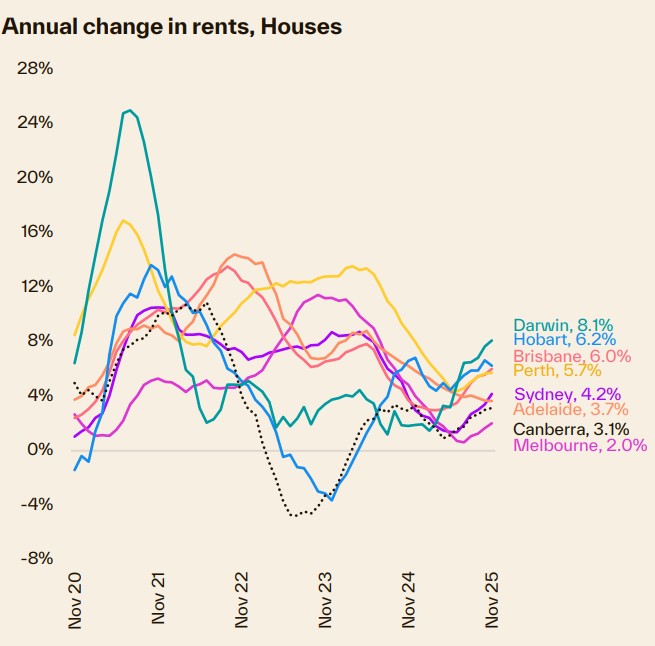
Dwelling rents are rising across every capital city, with Darwin and Hobart leading the annual gains.
Melbourne, Canberra and Adelaide are recording the mildest rental upswings, with Adelaide the only capital where annual rental growth is on an easing trajectory.
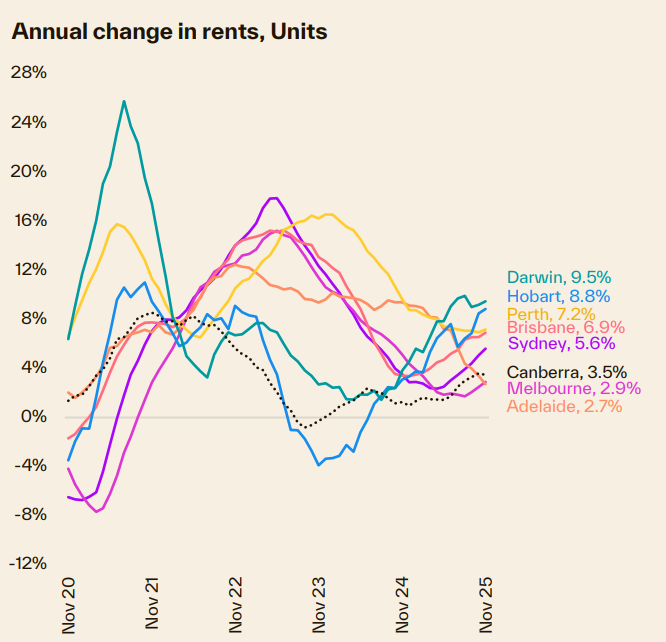
Sydney continues to record the lowest gross rental yields, at just 3.0%.
Despite this, NSW also recorded the highest share of investment activity over the September quarter, according to the ABS, with investment lending comprising 46.2% of mortgage demand by value, the highest share since the second quarter of 2017.

Sydney
| Property Type | Rent ($) | Weekly change | Monthly change | 12 Months change |
|---|---|---|---|---|
| All Houses | $1,112.26 | -6.26 | -0.6% | 6.8% |
| All Units | $730.39 | -0.39 | 0.4% | 5.8% |
| Combined | $885.25 | -2.79 | -0.1% | 6.3% |
Source: SQM Research
Melbourne
| Property Type | Rent ($) | Weekly change | Monthly change | 12 Months change |
|---|---|---|---|---|
| All Houses | $771.49 | -0.49 | 0.2% | 3.2% |
| All Units | $562.60 | -1.60 | -0.2% | 3.6% |
| Combined | $649.96 | -1.07 | 0.0% | 3.5% |
Source: SQM Research
Brisbane
| Property Type | Rent ($) | Weekly change | Monthly change | 12 Months change |
|---|---|---|---|---|
| All Houses | $777.99 | 0.01 | 0.0% | 7.0% |
| All Units | $618.43 | 1.57 | 0.7% | 6.1% |
| Combined | $706.15 | 0.71 | 0.3% | 6.7% |
Source: SQM Research
Perth
| Property Type | Rent ($) | Weekly change | Monthly change | 12 Months change |
|---|---|---|---|---|
| All Houses | $844.74 | 0.26 | 2.2% | 5.2% |
| All Units | $649.04 | -2.04 | 0.2% | 4.8% |
| Combined | $763.83 | -0.64 | 1.5% | 5.1% |
Source: SQM Research
Adelaide
| Property Type | Rent $) | Weekly change | Monthly change | 12 Months change |
|---|---|---|---|---|
| All Houses | $685.20 | 2.80 | 0.4% | 2.7% |
| All Units | $523.54 | 2.46 | 0.9% | 5.5% |
| Combined | $630.57 | 2.73 | 0.6% | 3.5% |
Source: SQM Research
Canberra
| Property Type | Rent ($) | Weekly change | Monthly change | 12 Months change |
|---|---|---|---|---|
| All Houses | $793.95 | -5.95 | 1.4% | 2.4% |
| All Units | $576.84 | 1.16 | 0.6% | 2.5% |
| Combined | $674.86 | -2.17 | 1.0% | 2.3% |
Source: SQM Research
Darwin
| Property Type | Rent ($) | Weekly change | Monthly change | 12 Months change |
|---|---|---|---|---|
| All Houses | $764.33 | 5.67 | 1.7% | 0.5% |
| All Units | $574.72 | 2.28 | -0.7% | 8.0% |
| Combined | $652.24 | 3.69 | 0.5% | 4.4% |
Source: SQM Research
Hobart
| Property Type | Rent 9$) | Weekly change | Monthly change | 12 Months change |
|---|---|---|---|---|
| All Houses | $601.04 | -1.04 | 1.8% | 11.4% |
| All Units | $508.58 | -1.58 | 3.7% | 9.8% |
| Combined | $564.16 | -1.24 | 2.5% | 10.9% |
Source: SQM Research
National
| Property Type | Rent ($) | Weekly change | Monthly change | 12 Months change |
|---|---|---|---|---|
| All Houses | $743.00 | -5.00 | -0.1% | 5.1% |
| All Units | $582.00 | 2.00 | 1.6% | 5.6% |
| Combined | $668.41 | -1.75 | 0.5% | 5.3% |
Source: SQM Research
Cap City Average
| Property Type | Rent ($) | Weekly change | Monthly change | 12 Months change |
|---|---|---|---|---|
| All Houses | $881.00 | -4.00 | 0.0% | 5.0% |
| All Units | $649.00 | -1.00 | 0.0% | 5.4% |
| Combined | $757.73 | -2.39 | 0.0% | 5.2% |
Source: SQM Research
Sellers of good properties are on strike
Despite a healthy lift in new listings, total listings remain subdued, with a strong rate of absorption from sales keeping stock levels low.
At the national level, Cotality observed 127,833 properties advertised for sale over the four weeks to October 26th, down -14.8% from those seen this time last year and -18.3% below the average for this time of year.
The spring selling season has continued to ramp up, with 43,503 newly advertised listings counted over the four weeks to October 26th.
While up 37.0% compared to the levels seen at the end of July, the flow of new listings remains -3.0% below the levels seen this time last year and roughly in line with the previous five-year average.

Vendor metrics
As the following chart shows, it's taking longer to sell a home.

The national median time on market inched higher over the three months to October to 29 days, up from 28 days in Q3.
While above the selling times seen this time last year, properties are currently selling around a week faster than the average over the past decade (37 days), with Hobart (31 days) being the only capital to see its median days on market exceed the 10-year benchmark (20 days).
